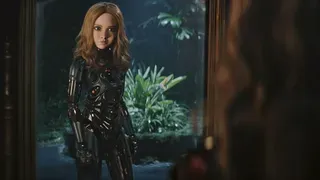July 18, 2013
The Conjuring
Kevin Taft READ TIME: 4 MIN.
Director James Wan ("Saw," "Insidious") isn't one to be subtle. In his latest horrorfest, "The Conjuring," he does his best stab at subtlety and almost reaches new heights, but he still finds ways to slam on the excess. However... by combining his tastes for a deafening score and even louder special effects, Wan has started to allow himself to delve into the quieter moments of horror to create something of a throw-back to the spooky horror films of the late '70s and early '80s.
His new film works in a twofold way. It is a film about the early years of Ed and Lorraine Warren (played by Patrick Wilson and Vera Farmiga respectively) -- the famous ghost-hunting couple that devoted their lives to helping out those that believe they are haunted. Most famously, they investigated the Amityville Horror house. Over the years, they came under scrutiny by both skeptics and those involved in cases they had worked on, but the two remained steadfast in their resolve that ghosts and demons are real, and that they were chosen to help those that couldn't help themselves.
The other part of the film focuses on one of the Warren's most frightening and least-discussed cases; that of the Perron family. In rural Rhode Island the couple moved with their four children to a farm house in rural Rhode Island, and soon started to notice supernatural phenomena. At first it was only noises and whispering; soon enough, whatever was in their house became physically violent and then started to target one member of the family for possession.
The family consists of Carolyn (Lili taylor), Roger (Ron Livingston), and their children, played by Mackenzie Foy, Hayley McFarland, Shanley Caswell, and Joey King. The time is the '70s, so Wan is able to play with the decade's rules: No cell phones, no Internet, and a general sense of isolation.
The one thing the family does do to pass the time is play a game called Double-Clap, where one person is blindfolded while the other players hide. The blind person asks the players to clap so they can try to find them. This clever game is used to an incredibly spooky effect a number of times in the film and goes to show how scary something so benign can be. (And hanging laundry will never be the same experience again after watching this movie.) Once things start to get more threatening and it's apparent that there is something reeeeally wrong inside the house, Carolyn discovers the Warrens at a college seminar. She begs for their help, and, being the do-gooders that they are, they agree to come see her home.
But the Warrens have their own issues as well. Lorraine is the medium of the two and can pick up on positive and negative energy, see spirits, and can read the future and the past. Ed is the more practical investigator, using the technology of the time to find cold spots and hear voices. But, because Lorraine had a bad experience during an exorcism and is still haunted by it, the trips to the homes and people that are actually being haunted (many have logical explanations) take its toll. For that, Ed is worried for her, but Lorraine is a trooper and really wants to help people find their peace.
What's so effective about "The Conjuring" is how Wan takes a library of horror movie clich�s and makes them work even when we know what he's doing. Whether it be a sudden silence that signals a big scare is coming, a dark corner where you know something is lurking, loud crashes, whispering voices, long camera takes that pan back and forth only for the viewer to be suddenly startled by what has appeared in the frame, they all work beautifully. For sure, these tricks have all been done many times in the past and Wan uses knowingly tickles us because we not only know what he's doing, but we also know he's still going to scare the bejesus out of us anyway.
He also takes his time in setting up the characters and allowing them to breathe a bit so we get to know and care about them. This device can create some unsettling moments as things start to creep into paranormal territory. Along with cinematographer John R. Leonetti, Wan masterfully sets up shots and situations that establish mood and keep us on edge as we wait for the creeps to occur. The house, designed by Geoffrey S. Grimsman, is effectively chilling with long hallways, odd corners, old clunky doors, and wooden floors that go creak in the night. There's also that hidden cellar. Oh, that hidden cellar.
All the players here do an exemplary job of elevating what could have been a schlockfest and making it a horror movie with a pedigree. Farmiga underplays her role as Lorraine, giving her an earnest balance of wanting to get her hands dirty, but being afraid just the same. Wilson dons an unusual New England accent (Boston meets Maine), playing it straight and serious, with a clear love and respect for his wife. Taylor gets the meatiest role as she must go from loving mother to frightened matriarch to something much more worrisome.
"The Conjuring" isn't going to rewrite the modern horror movie, but it gets one very important thing right: It makes scary movies fun again. Like the "Poltergeists" and "Amityville Horrors" of the past, this is a popcorn summer movie that will have you screaming with fright and glee -- often at the same time.
Kevin Taft is a screenwriter/critic living in Los Angeles with an unnatural attachment to 'Star Wars' and the desire to be adopted by Steven Spielberg.




